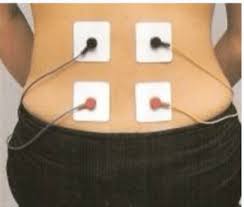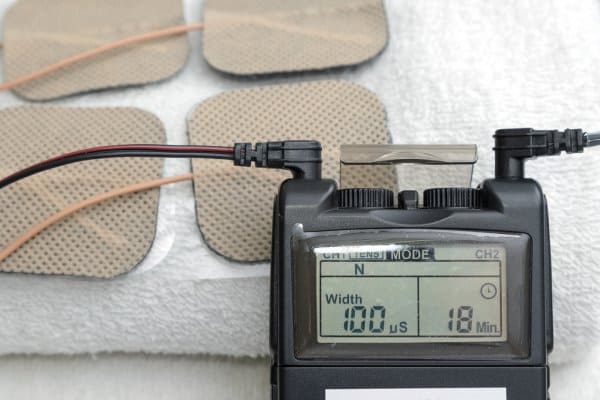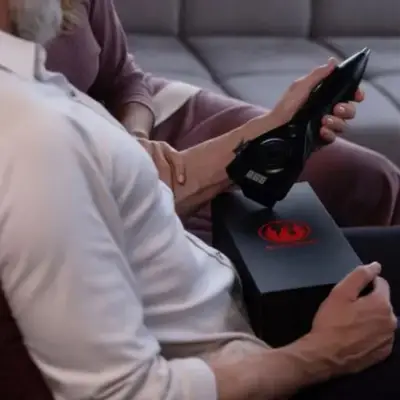A TENS unit can be a great way to get some relief from pain, even if it’s just temporary. E-stim treatment is often monitored by a medical professional, but there are some over-the-counter units you can use at home. It’s important that you know how to use it properly.
This question is typically referring to the frequency settings. The frequency is the main function that aids in pain relief, although the pulse width and mode you use will affect how the current is distributed and how the treatment feels.
Recommended frequencies are:
- Chronic pain: 2 – 10 Hz
- Moderate pain: 35 – 50 Hz
- Acute pain: 80 – 120 Hz
Chronic pain usually uses low frequencies on low pulse widths because the low frequencies cause your body to release endorphins where the pain is located. Endorphins are your body’s natural pain killers. They block the communication of pain signals to your brain and can sometimes produce a feeling of euphoria if they are strong enough.
If you’re using the machine on your own, these basic guidelines are a good place to start, but your doctor might want you to use lower or higher frequencies. Of course, if your doctor recommends something out of the ordinary, it’s best to follow their advice. You shouldn’t try these things on your own, though, because it could result in an injury.
Stronger frequencies don’t necessarily mean it’s providing more pain relief. In fact, it could mean quite the opposite. Skin burns and muscle tenderness can be caused by frequencies that are set too high. Continue reading for a comprehensive explanation of how TENS units work and how high you should set them.
Closely Follow the Instructions
Some TENS units come with only a few settings and others come with a lot more. The TENS devices that have a wide range of settings generally mean you have a broadened degree of control over how intense you want the settings to be.
For chronic and ongoing pain, you should keep your treatment settings somewhere between 2 Hz and 10 Hz. That doesn’t sound like much but it’s great for multiple, small treatments throughout the day when you’re dealing with ongoing, long-term plantar fasciitis.
To deal with moderate pain, set the frequency between 35 Hz and 50 Hz. Acute, high levels of pain may require you to go as high as 80 Hz to 120 Hz. Of course, you have to be careful when adjusting to very high settings.
You’re dealing with very high current, after all, and a TENS device is more than capable of doing the exact opposite of relieving pain. It can even burn the skin if you set it too high. The best method is the experimental one. Adjust the Hz between the settings for the kind of pain you’re dealing with.
Only make small adjustments at a time and allow some time on a single setting to see how your feet feel before you adjust the frequency even higher. The idea is to relieve pain, not create more pain and problems for yourself.
Why Should You Trust Me?

I have extensively used TENS units for neck, shoulder, back and heel pain. I’m certified by Relias Academy in TENS, interferential electrical stimulation, and neuromuscular electrical stimulation (NMES). With over 10 years of TENS unit therapy experience, I feel confident that my recommendations can help you lessen the aches and pains of everyday life.
How Does a TENS Unit Work?
TENS is an acronym for transcutaneous electrical nerve stimulation. It’s a type of electrical stimulation, also called e-stim.
E-stim uses electrical currents to help reduce various types of pain. TENS units send the currents to the nerves in your body. When the currents are sent to the nerves, it lowers the nervous system’s ability to send pain signals to the brain. So, you still have pain, but your brain isn’t able to interpret it as well while you’re receiving treatment.
TENS units can be used for the following types of pain:
- Joint, including arthritis
- Neck and back
- Muscle
- Neuropathic
- Fibromyalgia
- Post-operative
- Menstrual
They are sometimes used on women during labor to relieve pain, but some medical professionals advise against it because the long-term effects of TENS treatment on an unborn baby are unknown.
How to Use a TENS Unit
TENS units are often used during physical therapy, monitored by a medical professional. However, it’s possible to purchase units to use at home online or in stores.
While you can use them at home, you should check with your doctor or physical therapist before you begin to use it to make sure you use it correctly, so you don’t harm yourself. It’s possible to injure yourself with a TENS unit, which will be discussed in more detail in this article.
You should discuss where to place the electrodes and how long you should use it with your doctor. But, here is a general overview of how to properly use the machine.
Placing the Electrodes
The electrical currents pass from the TENS machine to your body via electrodes. Electrodes are the pads that are connected to the machine with wires. They stick onto your body with adhesive, so the area needs to be clean and dry before you place them. Electrodes can either be self-adhesive or require medical tape.
How Long Do TENS Electrode Pads Last? Click here to learn more.
Where to Place Electrodes
Unless your doctor says to do differently, electrodes should be placed directly where the pain is located. However, you shouldn’t place them directly on the joints, such as your elbow or knee. They won’t stick as well, and they could fall off.
Want to know where a TENS unit electrode pad can be placed? Check out my TENS placement guide here.
Here are some common TENS unit placements:
A study suggests that placing the electrodes on acupuncture points might receive great pain relief from doing so, but more research is needed.
When using multiple electrodes, you should place them near each other because the further apart they are, the less effective they are. They should have at least an inch of space between them.
Never use just one electrode at a time, as it will not be effective enough to aid with pain relief. Some TENS units might require you to use two or four, depending on the model.
Do not place electrodes on your eyes, face, neck, or on open wounds. This could cause serious injury and could be very painful. Blood pressure can be increased if they are placed on the neck or eyes.
How to Place Electrodes
You can place the electrodes by yourself. However, if you can’t quite reach the area on your own, you should find someone that can help you. You need to be precise when placing the electrodes, so it’s important to have someone helping you if it will help you be more accurate.
To place the electrodes:
- Begin with locating the area where you feel pain. This is where you will place the electrodes. Find the most painful or tender area, so long as it’s not directly on the joint.
- Clean and dry the skin where you will place the electrodes. The area needs to be clean, so the electrodes will stick and distribute the electrical currents properly. Make sure your skin is completely dry, as water can cause you to get electrocuted once the electrodes are attached.
- Prepare the adhesive if you need to do so. Some electrodes might require medical tape or another type of adhesive. Apply it as needed. Make sure the adhesive won’t irritate your skin.
- Optional: Apply conductive gel on your skin. This will help the electrode make better contact with your skin, which means it will be able to disperse the electrical currents more evenly.
- Place the electrodes on your skin. You can place them vertically, horizontally, or at an angle.
The direction you place the electrodes will depend on the area of your body. If the pain covers a large area, one electrode should be placed vertically at the top and one at the bottom in the same way. The painful area should be between the two electrodes.
If the pain covers a small area, the electrodes should be parallel to each other.
If you are using the TENS unit for joint pain, place the electrodes around the joint at the top and the bottom of the pain. The electrodes should be horizontal and parallel to each other.
You can place the electrodes at an angle if the pain is wide, and you need to cover more of it.
Can You Trim An Electrode Pad With Scissors? Click here to find out.
Example of TENS Placement for Lower Back Pain

If you have any doubts about placement, consult the TENS unit manual to see if it offers advice, or talk with a medical professional.
How Long Can You Use A TENS Unit?
How long you should use a TENS unit will depend on what kind of pain you need to use it for. You should speak to your doctor to get their recommendation or if you want to use it for extended periods of time.
Using a TENS unit for a lengthy session could cause injury to your muscles or skin. If you choose not to consult a doctor first, you should only use it for short intervals.
Acute Pain
Use it for 30 – 60 minutes at a time.
Do not use it for more than four sessions a day. Space out the sessions, so they aren’t used consecutively. Too much time with the TENS unit can cause muscle soreness.
Chronic Pain
Use it for 15 – 30 minutes at a time.
Do not use it for more than five sessions per week.
If these recommendations do not benefit you or you still have a lot of pain, consult a doctor. They might recommend different settings and durations or a different treatment plan.
TENS Unit Settings
A TENS unit has different settings that are used for different treatments. Each unit should have a manual that explains its settings and how they should be used. If your unit was given to you by a doctor or physical therapist, they should have given you their own instructions, and they will be able to answer any questions you might have.
Modes
A TENS unit should have three different modes: normal, burst, and modulation. The modes control how the electrical currents are dispersed.
- Normal: This mode provides constant stimulation that’s ideal for relieving acute pain. It’s the most basic setting on a unit and is typically the first one you try when you use the unit for the first time.
- Burst: This mode is generally used for chronic pain. It sends a burst of stronger currents. Those who suffer from chronic pain might want to use this setting when their pain is worse than usual.
- Modulation: This mode is appropriate for both acute and chronic pain. This is a “random” mode that cycles between different frequencies. They shock the nerves to reduce pain and give relief.
Frequencies
Frequencies are measured by hertz, which is the unit of measure for electromagnetic waves. One hertz, or Hz, is best described as one cycle per second.
In TENS units, you should be able to set the frequency to the level you want to use. High frequencies can feel uncomfortable and cause skin burns. The sensation you get from a TENS unit feels like tingling. That tingling comes from the electromagnetic waves running through their cycles. So, the higher the frequency, the faster the cycle, and that’s what can cause irritation.
Pulse Widths
Pulse widths are another setting you should be able to control on your TENS unit. This is the duration that the current is sent. Low pulses are shorter than moderate pulses.
Low pulses are usually used for pain relief, while the longer pulses are used for blood circulation and muscle contraction.
If you’re using the machine on your own, these basic guidelines are a good place to start, but your doctor might want you to use lower or higher frequencies.
Of course, if your doctor recommends something out of the ordinary, it’s best to follow their advice. You shouldn’t try these things on your own, though, because it could result in an injury.
One thing to remember is that TENS therapy shouldn’t cause discomfort. If you feel any pain or irritation during the treatment, turn the frequency down until it feels comfortable.
Stronger frequencies don’t necessarily mean it’s providing more pain relief. In fact, it could mean quite the opposite. Skin burns and muscle tenderness can be caused by frequencies that are set too high.
Pulse and Mode
You might find that using a long pulse width with a high frequency will be very uncomfortable, so you might want to use settings that are opposite to each other. If you use a high frequency, use a low pulse. If you use a low frequency, use a high pulse.
The normal mode should be suitable for all frequencies. Using high frequencies with burst or modulation modes might be uncomfortable since the burst will use sudden strong currents, and the modulation mode will switch between different currents.
You can use any mode as long as it doesn’t cause you any pain or if your doctor says it will be safe for you to use.
TENS Unit Safety Guidelines
A TENS unit is a medical device, even though you can purchase them online and use them at home for self-treatment. That being said, you should be careful when using the machine because it’s possible to injure yourself.
Be sure to follow the basic guidelines when using a TENS unit:
- Do not place the electrodes on your eyes, face, neck, or on open wounds.
- Do not go near water while you have the electrodes on you.
- Do not use the unit longer than the recommended session duration.
- If you feel discomfort, reduce the frequency or other settings as necessary.
- Do not fall asleep while using the unit so you can closely monitor how it affects you.
Possible Side Effects
There are some side effects that can come from using a TENS machine. Usually, these occur when the machine was used incorrectly and are often not too serious. Side effects can easily be prevented and treated.
Muscle Tenderness
Muscle tenderness occurs when you have used the TENS unit for too long. You can also experience tenderness if you used a frequency that was too high.
To prevent this, make sure you use a frequency that doesn’t make you feel uncomfortable. You should use a timer to keep track of how long you have been using it. You shouldn’t use the unit for more than an hour at a time unless a doctor says it is safe for you to do so.
Remember that you should only feel a gentle tingle underneath the electrodes.
Allergic Reaction
Some users might have an allergic reaction to the adhesive pads on the electrodes. Before you apply the electrode to your skin, be sure to read the TENS unit manual to find out what kind of adhesive it uses. You can find a type that doesn’t have adhesive on it, so you can choose which adhesive you want to use that is safe for you.
Skin Irritation
This might be caused by an allergic reaction, but it can also be a result of prolonged use. Be sure to clean your skin before you use the machine and change out the electrode pads frequently if you use the unit often.
Who Shouldn’t Use a TENS Unit
A TENS unit is safe to use if you use it correctly and as advised, but people with certain conditions shouldn’t use it unless a doctor directs them to.
- Pregnant women: Although TENS units are occasionally used during labor, the long-term effects the electrical currents have on the baby are unknown. If a doctor tells a pregnant woman that she can use the machine, she will probably be told not to use it around her abdominal area.
- People with electrical implants: Pacemakers and other implants can contain metal or use electrical currents to operate. The electrical currents from the TENS unit could interfere with these devices and cause them to malfunction. This could be critical to their health.
- People with epilepsy: It’s possible for the electrical currents to induce seizures in those who suffer from epilepsy, especially if the electrodes are placed anywhere on the head.
- People who have developed a tolerance: If you frequently use a TENS machine, it’s possible to build up a tolerance to the treatment. You might find that the intensity you have been using is no longer effective. Turning it up to feel it again can lead to muscle tenderness due to overexposure.
Conclusion
TENS therapy can ease pain by using electrical currents that block the pain signals from going to your brain. It only provides temporary relief, but it can benefit both acute and chronic pain. Acute pain should be treated with high frequencies of 80 Hz or higher, while chronic pain should be treated with low frequencies of no more than 10 Hz.
Sources
- For Your Massage Needs: TENS Unit Settings Explained
- Medical News Today: What is a TENS unit and does it work?
- Omron: TENS Unit Pad Placement: 10 Tips for Effective Use
- TENS: How to Set Those Dials
- TENS Unit Depot: How To Properly Use a TENS Unit
- Top TENS: TENS Side Effects : Can You Misuse a TENS Machine, and What Happens if You Do?
- UI Hospitals & Clinics: Transcutaneous electrical nerve stimulator (TENS)






26 responses to “Say Goodbye to Pain: How to Adjust your TENS Unit for Maximum Relief”
[…] Want to know how high you should set a TENS unit? Click here […]
[…] Read How High Can I Set My TENS Unit here […]
[…] High Should I Set My TENS Unit? click here to read what settings to […]
[…] Want to learn more about TENS settings? Check out my article here […]
[…] Wondering how high you can set your TENS unit? Check out my article here […]
[…] To read more about what type of settings are best check out my article: How High Should I Set My TENS Unit? […]
[…] Want to know how high you should set a TENS unit? Click here […]
[…] your settings for your TENS Unit too high? If so check out my article here to get the most out of your TENS unit safely and […]
[…] Read How High Can I Set My TENS Unit here […]
[…] to know which setting to use for a TENS unit? Click here to learn […]
[…] to know how high you can set a TENS unit? Click here to learn […]
[…] how high you can set a TENS unit? Click here to read […]
[…] Want to learn about TENS setting? Click here […]
[…] A good rule of thumb is to go for the highest frequency you can tolerate without being in pain. TENS should feel strong but only tingly, without pain. Want know more about TENS settings? Click here. […]
[…] A recent study from July 2021 found that high intensity TENS treatment effectively decreased pain in women who breastfed. To learn more about TENS unit settings and how they work click here. […]
[…] to know how TENS settings work? Click here to learn […]
[…] Always turn your unit off before removing your pads and be sure to properly check your skin for any unwanted side effects after use. To read more about TENS settings click here. […]
[…] Need to know how to use the settings on your TENS unit? Click here […]
[…] to know how high you can set a TENS Unit click here to learn […]
[…] To learn how to understand the various TENS unit settings click here […]
[…] To read how high you can set a TENS unit click here. […]
[…] Learn how to use TENS settings here […]
[…] To learn more about TENS unit settings click here. […]
[…] Wondering how high can you set a TENS Unit? Learn more here. […]
[…] Want to know how high you can set a TENS Unit? Check out my article here. […]
[…] To learn about TENS Unit Settings click here. […]